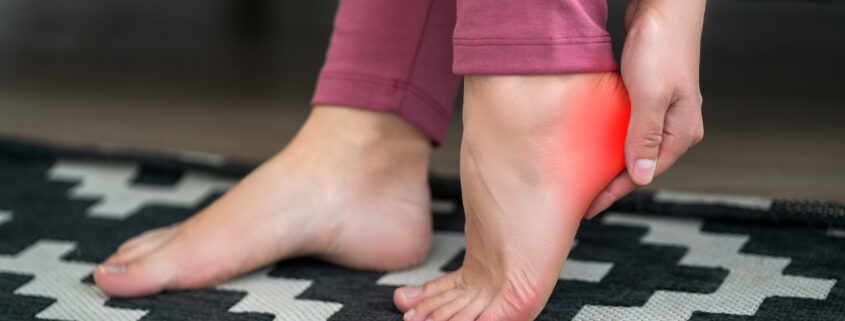What Causes Heel Spurs?
Heel spurs are bony growths on the bottom of the heel bone caused by stress on the foot muscles and ligaments. Repetitive activities, such as running or jumping, commonly cause heel spurs, as they stress the heel and surrounding tissues.
Heel spurs often result in discomfort and pain that interfere with daily activities. They can make performing routine tasks such as walking, running, or standing difficult for extended periods. The intensity of the pain may vary, and in some cases, it could persist for months, affecting your mobility and quality of life.
At Missouri Foot & Ankle, we offer expert diagnosis and treatment for heel spurs. Our team is here to help you find relief and quickly return to regular activities. If you’re experiencing heel spur symptoms, contact us to schedule an appointment.
What Causes Tendonitis?
Achilles tendon pain is frequently caused by intense physical activity, including running. Frequent stops and starts, as well as pushing off motions, such as when one is running or training for intense sports, can lead to tendon injuries and affect the athlete’s performance if the Achilles tendon is put under too much stress.
Understanding Heel Spurs
Heel spurs are essentially bony growths that take shape due to an accumulation of calcium deposits. They can occur at the back of or underneath your heel or even beneath the sole of your foot. This condition is not just a simple foot discomfort but a medical condition requiring professional attention.
Over time, these calcium deposits tend to form due to continual stress on the muscles, ligaments, or the plantar fascia that spans the underside of your foot. The strain can come from everyday activities but is particularly common in running or jumping individuals.
If not treated properly and promptly, heel spurs can lead to sharp pain in the heel, especially when you stand up after rest or first thing in the morning. The pain can become chronic if left untreated, causing discomfort that can seriously impact your quality of life. The visible signs of heel spurs, such as a bony protrusion under the heel, may also appear over time.
Relation to Plantar Fasciitis
Heel spurs can frequently develop in response to the stress and inflammation associated with plantar fasciitis, a prevalent foot condition identified by discomfort and swelling in the plantar fascia. This thick tissue band connects your heel bone to your toes. The strain on this ligament can lead to the development of heel spurs, further complicating the discomfort and pain in your foot.
The role of the plantar fascia ligament is crucial in understanding heel spurs. Its job is to absorb shock and support the arch of your foot to assist in walking. However, excessive pressure or strain on this ligament, often due to intense physical activity or obesity, can develop plantar fasciitis. If you’re experiencing persistent pain in your heel, it may be due to the combination of plantar fasciitis and heel spurs.
Symptoms of Heel Spurs
Heel spurs are often associated with various symptoms that can significantly affect one’s ability to carry out daily activities. One of the most common symptoms is a sharp pain in the heel, particularly noticeable when standing or walking after periods of rest. This pain is often most acute in the morning or after sitting for a long time. Besides pain, you may also notice inflammation and swelling at the front of the heel, signs that suggest a potential heel spur.
The duration of these symptoms can vary, leading to the question: How long do heel spurs last? It largely depends on the individual and the severity of the condition. Some patients may find their symptoms subside relatively quickly, within a matter of weeks. However, for others, heel spurs may persist for several months. It’s important to remember that each case is unique, and the timeframe can vary significantly.
At Missouri Foot & Ankle, we understand heel spurs’ impact on your daily life. Our team provides prompt and effective treatment to alleviate your symptoms quickly. If you’re experiencing the symptoms associated with heel spurs, contact us to schedule an appointment.
Causes of Heel Spurs
Heel spurs can result from various factors that place excessive stress on the foot. These contributing factors include:
- Gait Abnormalities: Irregular walking patterns can stress the heel bone and its associated soft tissues, potentially leading to heel spur formation. Conditions like flat feet or high arches can affect weight distribution during standing and walking, increasing the risk of heel spurs.
- Running on Hard Surfaces: Jogging or running on unyielding surfaces can significantly strain foot ligaments and muscles, facilitating the development of calcium deposits and subsequent heel spurs. Persistent heel pain should be a concern for regular runners and athletes.
- Ill-Fitting Shoes: Wearing shoes that lack proper support or cushioning can strain the feet, causing inflammation and the growth of heel spurs. Shoes that are incorrectly fitted or lack adequate arch support significantly increase this risk.
- Obesity: Carrying excess weight places added pressure on the feet, potentially leading to conditions like plantar fasciitis and heel spurs. Effective weight management is crucial for preventing and managing heel spurs.
Treatment Options
Heel spurs have several treatment options, with each approach tailored to an individual’s specific needs and the severity of the condition:
- Physical Therapy: Physical therapy helps strengthen foot muscles and ligaments, reducing strain and facilitating healing. Therapeutic exercises and stretching routines often alleviate pain and enhance mobility.
- Over-the-counter pain Medications: Non-prescription pain medications can effectively manage heel spur symptoms. They work by reducing inflammation and providing temporary relief from heel spur-related pain. People often take these medications alongside other treatment methods to create a comprehensive approach.
- Heel Spur Surgery (in Severe Cases): In severe instances where conservative methods do not provide significant relief, surgeons may need to remove the heel spur. This procedure involves removing it and releasing tension in the plantar fascia ligament, relieving pain and restoring foot function.
At Missouri Foot & Ankle, we design personalized treatment plans for our clients, ensuring they receive the most effective care for their conditions.
Prevention of Heel Spurs
Preventing heel spurs can save you from the discomfort and inconvenience of this condition. Here are some prevention tips:
- Wear properly fitted shoes with supportive and cushioned soles to distribute pressure evenly and reduce inflammation.
- To strengthen foot muscles, perform regular foot exercises, such as toe stretches, calf raises, and towel curls.
- Maintain a healthy weight to avoid excess stress on your feet.
- Avoid running or walking on hard surfaces to prevent overworking foot muscles and ligaments.
- Get strategies to minimize foot impact if your activity or job involves extensive walking or running from Missouri Foot & Ankle.
- To strengthen foot muscles, perform regular foot exercises, such as toe stretches, calf raises, and towel curls.
At Missouri Foot & Ankle, our podiatrists in St. Louis can guide you through exercises tailored to your needs, promoting foot health and preventing conditions like heel spurs.
Missouri Foot & Ankle: Your Heel Pain & Spur Experts
Your foot health significantly impacts your overall well-being and mobility. If you’re experiencing symptoms that could be related to heel spurs, such as persistent heel pain, it’s essential to seek professional help. At Missouri Foot & Ankle, our team of experts can provide a thorough examination, accurate diagnosis, and develop a treatment plan to manage your condition effectively.
Contact us if you have heel pain or suspect a heel spur. Our team will ensure you receive the best treatment options to alleviate your symptoms and restore your foot health. We’re here to help you every step of the way.





